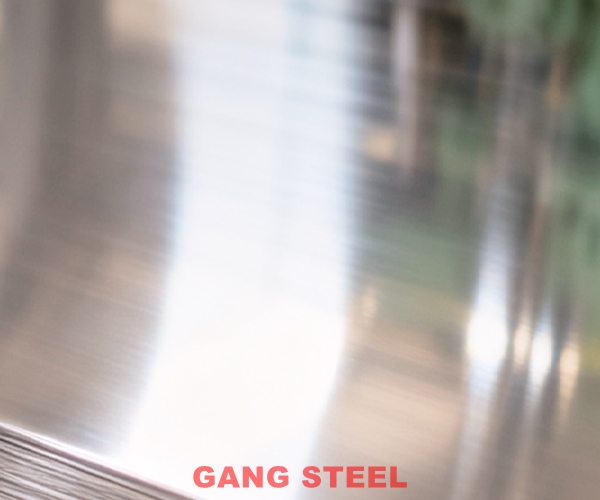Product List
Gangsteel Material Solution
Email: admin@gangsteel.com
Sales: jack@gangsteel.com

Published: November 8, 2025 | Updated: November 8, 2025By Gangsteel Engineering Team – 25+ Years in Stainless Steel Export Excellence
316Ti stainless steel, known as UNS S31635 or EN 1.4571, is a titanium-stabilized austenitic grade that excels in resisting intergranular corrosion at high temperatures while maintaining strong general resistance to various corrosives.
As a premier producer and exporter based in China, Gangsteel has supplied thousands of tons of ASME SA240 316Ti and ASTM A240 316Ti plates, sheets, and bars to industries like petrochemical, marine, and food processing.
If you're assessing this material for environments with acids, chlorides, or seawater, understanding its corrosion resistance is key. This guide provides a detailed table of corrosion resistance, based on industry data and our mill tests, along with explanations and tips for optimal use.
From our facilities, we've seen 316Ti perform: In a 2024 U.S. chemical plant, our 316Ti components resisted dilute sulfuric acid at 60°C with rates <0.1 mm/year, outperforming standard 316 in pitting tests. Often spec'd under ASTM A240 /A240M for general use or ASME SA240/SA240M for pressure vessels, 316Ti's PREN of 23-28 and density of 8.00 g/cm³ support durable designs. The table below summarizes resistance in common environments; note that actual rates depend on conditions like temperature, concentration, and aeration.
316Ti stainless steel offers excellent corrosion resistance with a PREN of 23-28, superior to 304 in pitting and IGC due to Mo and Ti stabilization. It resists dilute acids (<0.1 mm/year in sulfuric), moderate chlorides (CPT ~25°C), but is not ideal for full seawater immersion without coatings. High-temp stability prevents sensitization up to 815°C. Compared to 316L, 316Ti better handles sustained heat. Under ASME SA240 316Ti and ASTM A240 316Ti, it's ideal for chemical and marine apps. Gangsteel stocks 1-200mm thick with certs for global use.
The table below compiles corrosion resistance data for 316Ti in various environments, including rates where available (mm/year) at room temperature unless noted. Data is indicative; consult specific tests for your app.
|
Environment |
Corrosion Type |
Resistance Level |
Typical Rate (mm/year) |
Notes |
|---|---|---|---|---|
|
Atmosphere (Urban/Rural) |
Uniform/Pitting |
Excellent |
<0.01 |
Good passivation; resists rust in humid air. |
|
Fresh Water |
Uniform |
Excellent |
<0.01 |
Stable oxide layer; suitable for boilers. |
|
Seawater (19,000 ppm Cl) |
Pitting/Crevice |
Moderate |
0.05-0.1 (passive) |
Not recommended for prolonged immersion; risk of localized attack; use coatings for marine. |
|
Diluted Sulfuric Acid (<10%, RT) |
Uniform |
Moderate |
<0.1 |
Good in dilute; avoid concentrated/hot. |
|
Acetic Acid (Boiling) |
Uniform/IGC |
Good |
<0.1 |
Ti stabilization prevents IGC; better than 316. |
|
Nitric Acid (Boiling) |
Uniform |
Excellent |
<0.05 |
Strong resistance; common in chemical processing. |
|
Chlorides (Low, <1,000 ppm) |
Pitting |
Excellent |
<0.01 |
Mo enhances; CPT ~25°C in FeCl3. |
|
High Temperature (425-815°C, Air) |
Oxidation/IGC |
Excellent |
<0.1 |
Ti prevents carbide precipitation; no sensitization. |
|
Sour Gas (H2S, Low Conc.) |
SCC/Uniform |
Good |
<0.05 |
NACE compliant if hardness controlled; suitable for oil & gas. |
|
Fruit/Vegetable Juices |
Uniform |
Excellent |
<0.01 |
Non-reactive; food-safe. |
Data sourced from material datasheets and tests; rates approximate and depend on factors like aeration and flow. For severe conditions, consult Gangsteel for custom tests.
Gangsteel's 316Ti SA240 Type 316Ti stock shows <0.05 mm/year in boiling acetic.
Hardness 95 HRB max and yield 205 MPa ensure 316Ti withstands corrosive stresses without deformation.
316Ti's table suits chemical reactors (acid resistance), marine piping (chloride pitting), food processing (uniform low rates).
In Gangsteel's supply to U.S. pharma, 316Ti resisted nitric acid without loss.
Equivalents: EN 1.4571, JIS SUS316Ti—matching table profiles.
Gangsteel stocks 316Ti at $3,200-3,800/ton FOB. 1-200mm thick, certs included. Contact for corrosion data.
Q: What is the corrosion resistance of 316Ti in seawater?
A: 316Ti has moderate resistance to seawater pitting (rate 0.05-0.1 mm/year passive), but not recommended for prolonged immersion without coatings due to chloride risk; PREN 23-28 aids but crevice attacks possible.
Q: How does 316Ti perform in diluted acids?
A: Excellent in dilute acids like sulfuric (<10%, RT) with rates <0.1 mm/year; Ti stabilization prevents IGC in heat.
Q: What is 316Ti's resistance to high-temperature corrosion?
A: Excellent oxidation/IGC resistance up to 815°C (<0.1 mm/year in air); Ti prevents carbide precipitation for sustained durability.
Q: Is 316Ti resistant to chloride corrosion?
A: Yes, good in low chlorides (<1,000 ppm, <0.01 mm/year); CPT ~25°C, suitable for marine but monitor crevices.
Q: What is the corrosion rate of 316Ti in acetic acid?
A: <0.1 mm/year in boiling acetic acid; Ti ensures no IGC, making it reliable for chemical processing.
Q: How does 316Ti compare to 316 in corrosion resistance?
A: Similar general resistance, but 316Ti better prevents IGC at high temps due to Ti; both PREN 23-28 for pitting.
Q: What factors affect 316Ti's corrosion resistance?
A: Temperature (stable to 815°C), concentration (dilute better), flow (reduces rates), surface (polished enhances), and environment (oxygen aids passivation).
ASTM A516 GR 70 equivalent materials is such as ASME SA516 GR 70, EN 10028 P355GH, and BS1501 224-490 A & B, sh
we supply high-quality A516 Gr 70 steel plate for pressure vessel applications and other standards like ASTM A2
EN10028-2 P355GH for High-Strength Low-Alloy Columbium-Vanadium Structural Steel EN10025-2 S355J2 Structural St
We export A240 304L Stainless Coil 2B, NO.1 No.4 surface, the thickness 0.1mm to 3mm, 3mm to 22mm, Mother mill